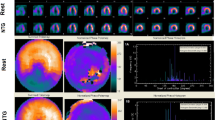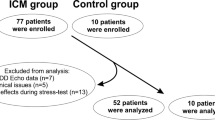Abstract
Objective
Transient left ventricular contractile dysfunction (TLVD) is observed owing to post-exercise stunning in patients with coronary artery disease (CAD). Pharmacological stimulation differs from exercise stress because it does not cause demand ischemia. The aim of this study was to determine whether TLVD could also be seen after pharmacological stress (dipyridamole).
Methods
Of the patients in whom gated single-photon emission computed tomography (GSPECT) was performed in our institution from January 2004 to April 2007, 439 subjects with known or suspected CAD were included in the study. GSPECT was performed for all patients following exercise (group I, n = 220) or pharmacological stress (group II, n = 219) according to a 2-day (stress-rest) protocol after injection of Tc-99m methoxyisobutyl-isonitrile (MIBI). Stress, rest, and difference (stress-rest value) left ventricular ejection fractions (SLVEF, RLVEF, and DLVEF) and transient ischemic dilatation (TID) ratio were derived automatically. Summed stress score, summed rest score, and summed difference score (SDS) for myocardial perfusion were calculated using a 20-segment model and a five-point scoring system. An SDS > 3 was considered as ischemic. On the basis of the perfusion findings, patients were subdivided into a normal (group A, n = 216) and ischemia group (group B, n = 223). DLVEF and perfusion scores of all groups were compared. Relationships between DLVEF and perfusion, and between TID ratio and DLVEF were also evaluated.
Results
Stress-induced ischemia was observed in 223 of 439 patients (50.8%). In group A, the difference between stress and rest LVEF values was not significant (P = 0.670 and P = 0.200 for groups IA and IIA, respectively). However, LVEF was significantly decreased after stress compared with rest values for group B (P < 0.0001 for groups IB and IIB). TLVD (≤−5% for DLVEF) was observed in 20 of 216 (9%) and 81 of 223 subjects (36%) in patients in groups A and B, respectively (P < 0.0001). In group I, we found TLVD in 46 of 119 (39%) and 12 of 101 (12%) subjects, in patients with and without ischemia, respectively (P < 0.0001). On the other hand, in group II, TLVD was detected in 35 of 104 (34%) and 8 of 115 (7%) patients with and without ischemia, respectively (P < 0.0001). And also, we found significant good correlations between TID ratios and DLVEF values in four subgroups (r = −0.55, r = −0.62, r = −0.59, and r = −0.41; for groups IA, IB, IIA, and IIB, respectively, P < 0.0001 for all).
Conclusions
Dipyridamole is believed to be less likely than exercise to induce ischemia. However, in this study, TLVD after stress was observed following not only exercise but also pharmacological stress, consistent with ischemia.
Similar content being viewed by others
References
Braunwald E, Kloner RA. The stunned myocardium: prolonged, postischemic ventricular dysfunction. Circulation 1982;66:1146–1149.
Iwado Y, Furuyama H, Yoshinaga K, Mabuchi M, Ito Y, Noriyasu K, et al. Transient left ventricular dysfunction in ischaemic myocardium after stress: comparative study with exercise and pharmacological stress gated myocardial single photon emission computed tomography. Nucl Med Commun 2003;24:551–557.
Stollfuss JC, Haas F, Matsunari I, Neverve J, Nekolla S, Schneider-Eicke J, et al. Regional myocardial wall thickening and global ejection fraction in patients with low angiographic left ventricular ejection fraction assessed by visual and quantitative resting ECG-gated 99mTc-tetrofosmin single-photon emission tomography and magnetic resonance imaging. Eur J Nucl Med 1998;25:522–530.
Fleming RM. A tête-à-tête comparison of ejection fraction and regional wall motion abnormalities as measured by echocardiography and gated sestamibi SPECT. Angiology 2002;53:313–321.
Patel CD, Nadig MR, Kurien S, Barai S, Narang R, Malhotra A. Left ventricular ejection fraction and volumes on rest gated 201Tl perfusion SPECT: comparison with two-dimensional echocardiography. Nucl Med Commun 2006;27:425–429.
Nichols K, Lefkowitz D, Faber T, Folks R, Cooke D, Garcia EV, et al. Echocardiographic validation of gated SPECT ventricular function measurements. J Nucl Med 2000;41:1308–1314.
Berk F, Isgoren S, Demir H, Kozdag G, Sahin T, Ural D, et al. Assessment of left ventricular function and volumes for patients with dilated cardiomyopathy using gated myocardial perfusion SPECT and comparison with echocardiography. Nucl Med Commun 2005;26:701–710.
Paul AK, Kusuoka H, Hasegawa S, Yonezawa T, Makikawa M, Nishimura T. Prolonged diastolic dysfunction following exercise induced ischaemia: a gated myocardial perfusion SPECT study. Nucl Med Commun 2002;23:1129–1136.
Toba M, Kumita S, Cho K, Ibuki C, Kumazaki T, Takano T. Usefulness of gated myocardial perfusion SPECT imaging soon after exercise to identify postexercise stunning in patients with single-vessel coronary artery disease. J Nucl Cardiol 2004;11:697–703.
Matsuo S, Matsumoto T, Nakae I, Koh T, Masuda D, Takada M, et al. Prognostic value of ECG-gated thallium-201 singlephoton emission tomography in patients with coronary artery disease. Ann Nucl Med 2004;18:617–622.
Emmett L, Iwanochko RM, Freeman MR, Barolet A, Lee DS, Husain M. Reversible regional wall motion abnormalities on exercise technetium-99m-gated cardiac single photon emission computed tomography predict high-grade angiographic stenoses. J Am Coll Cardiol 2002;39:991–998.
Hung GU, Lee KW, Chen CP, Yang KT, Lin WY. Worsening of left ventricular ejection fraction induced by dipyridamole on Tl-201 gated myocardial perfusion imaging predicts significant coronary artery disease. J Nucl Cardiol 2006;13:225–232.
Lee DS, Yeo JS, Chung JK, Lee MM, Lee MC. Transient prolonged stunning induced by dipyridamole and shown on 1-and 24-hour poststress 99mTc-MIBI gated SPECT. J Nucl Med 2000;41:27–35.
Tanaka H, Chikamori T, Hida S, Usui Y, Harafuji K, Igarashi Y, et al. Comparison of post-exercise and post-vasodilator stress myocardial stunning as assessed by electrocardiogramgated single-photon emission computed tomography. Circ J 2005;11:1338–1345.
Druz RS, Akinboboye OA, Grimson R, Nichols KJ, Reichek N. Postischemic stunning after adenosine vasodilator stress. J Nucl Cardiol 2004;11:534–541.
Germano G, Kiat H, Kavanagh PB, Moriel M, Mazzanti M, Su HT, et al. Automatic quantification of ejection fraction from gated myocardial perfusion SPECT. J Nucl Med 1995;36:2138–2147.
Berman DS, Germano G. Evaluation of ventricular ejection fraction, wall motion, wall thickening, and other parameters with gated myocardial perfusion single-photon emission computed tomography. J Nucl Cardiol 1997;4:169–171.
Johnson LL, Verdesca SA, Aude WY, Xavier RC, Nott LT, Campanella MW, et al. Postischemic stunning can affect left ventricular ejection fraction and regional wall motion on posts-tress gated sestamibi tomograms. J Am Coll Cardiol 1997;30:1641–1648.
Ben-Haim S, Gips S, Merdler A, Front A, Tamir A. Myocardial stunning demonstrated with rest and post-stress measurements of left ventricular function using dual-isotope gated myocardial perfusion SPECT. Nucl Med Commun 2004;25:657–663.
Kronenberg MW, Becker LC. Myocardial perfusion imaging. In: Sandler MP, Coleman RE, Patton JA, Wackers FJ, Gottschalk A, editors. Diagnostic nuclear medicine. Philadelphia: Lippincott Williams and Wilkins; 2003. p. 273–2318.
McLaughlin MG, Danias PG. Transient ischemic dilation: a powerful diagnostic and prognostic finding of stress myocardial perfusion imaging. J Nucl Cardiol 2002;9:663–667.
Hung GU, Lee KW, Chen CP, Lin WY, Yang KT. Relationship of transient ischemic dilation in dipyridamole myocardial perfusion imaging and stress-induced changes of functional parameters evaluated by Tl-201 gated SPECT. J Nucl Cardiol 2005;12:268–275.
Santiago JF, Heiba SI, Jana S, Mirzaitehrane M, Dede F, Abdel-Dayem HM. Transient ischemic stunning of the myocardium in stress thallium-201 gated SPET myocardial perfusion imaging: segmental analysis of myocardial perfusion, wall motion and wall thickening changes. Eur J Nucl Med Mol Imaging 2002;29:979–983.
Mottram PM, Haluska B, Yuda S, Leano R, Marwick TH. Patients with a hypertensive response to exercise have impaired systolic function without diastolic dysfunction or left ventricular hypertrophy. J Am Coll Cardiol 2004;43:848–853.
Ha JW, Juracan EM, Mahoney DW, Oh JK, Shub C, Seward JB, et al. Hypertensive response to exercise: a potential cause for new wall motion abnormality in the absence of coronary artery disease. J Am Coll Cardiol 2002;39:323–327.
Cholewinski W, Stefaniak B, Poniatowicz-Frasunek E, Tarkowska A. Reduction of the LVEF measured with gSPECT after 1-3 hours after physical exercise in CAD. Nuklearmedizin 2004;43:150–157.
Ambrosio G, Betocchi S, Pace L, Losi MA, Perrone-Filardi P, Soricelli A, et al. Prolonged impairment of regional contractile function after resolution of exercise-induced angina: evidence of myocardial stunning in patients with coronary artery disease. Circulation 1996;94:2455–2464.
Author information
Authors and Affiliations
Corresponding author
Rights and permissions
About this article
Cite this article
Demir, H., Tan, Y.Z., Isgoren, S. et al. Comparison of exercise and pharmacological stress gated SPECT in detecting transient left ventricular dysfunction. Ann Nucl Med 22, 403–409 (2008). https://doi.org/10.1007/s12149-008-0119-2
Received:
Accepted:
Published:
Issue Date:
DOI: https://doi.org/10.1007/s12149-008-0119-2




